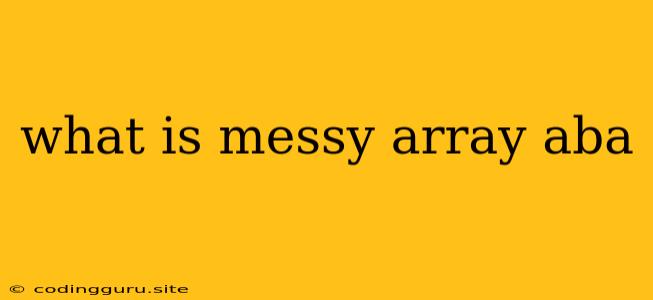What is a "Messy Array" and Why Should You Care?
You've probably encountered the term "array" in programming. But have you ever heard of a "messy array"? This might sound like an odd concept, but it's actually a very real and surprisingly common situation in programming.
In essence, a "messy array" is simply an array that doesn't adhere to a specific order or structure. It might be filled with a mix of data types, contain unexpected values, or have gaps in its data.
Think of it like this:
- A regular array is like a neatly organized bookshelf, where each book is in its designated place and all the books are similar in type.
- A messy array is like a cluttered attic. You might find random objects scattered about, some items might be broken or incomplete, and you might not know what you'll find next.
Why is this important?
While messy arrays might seem like a nuisance, they can actually be a significant source of problems for developers. This is because they introduce unpredictability and make it difficult to write clean and efficient code.
Here are some common scenarios where you might encounter messy arrays:
- Data from external sources: When importing data from a spreadsheet, database, or other sources, the data might not be perfectly formatted or organized. This can result in messy arrays.
- User input: User input is inherently unpredictable. Users might enter incorrect data types, missing values, or even malicious inputs. This can lead to messy arrays that require careful handling.
- Legacy code: Old codebases often contain messy arrays that were created before proper data structures were well-established.
- Dynamic programming: Some algorithms, particularly those involved in dynamic programming, might use messy arrays as a way to efficiently store intermediate results.
How do you deal with messy arrays?
It's important to be aware of the potential challenges messy arrays pose. Here are some tips for handling them:
- Validation: The first step is to validate the data in your messy array. This involves checking for valid data types, expected ranges, and potential inconsistencies.
- Cleaning: Once you've identified the issues, you can clean the messy array by removing invalid data, converting data types, and filling in missing values.
- Structuring: If you have a large amount of messy data, it might be beneficial to restructure it into a more organized format. This could involve creating new arrays, dictionaries, or other data structures.
- Defensive programming: Write code that handles potential errors and exceptions that might arise from messy arrays. This includes error handling, validation routines, and defensive checks.
- Documentation: Clearly document the structure and potential problems of your messy arrays. This will help you and other developers understand the code better.
Example
Let's say you have an array representing student scores:
scores = [85, "A+", 78, "Incomplete", 92, None, 80]
This is a messy array because it contains a mix of integers, strings, and even a None value. You might need to clean this array before you can calculate the average score, for example.
Conclusion
While "messy array" might seem like an informal term, it highlights a real problem in software development. By understanding what a messy array is and how to address it, you can write more robust and efficient code. Remember to validate your data, clean up messy arrays, and document your code well. This will save you time and prevent unexpected errors in the long run.
